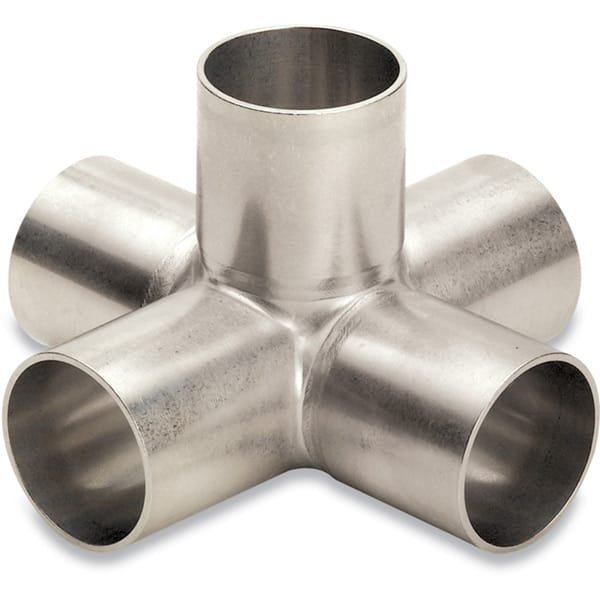Weldable Tube 5-Way Crosses for UHV Semiconductor Vacuum Systems
Weldable Tube 5-Way Crosses, fabricated by TFM, are precision-engineered for use in ultra-high vacuum (UHV) systems, particularly those found in semiconductor manufacturing environments. Constructed from high-grade 304 series stainless steel, these fittings offer exceptional cleanliness and mechanical performance for integration into foreline, pump exhaust, and roughing line infrastructure within subfab systems.
Each 5-way cross is meticulously manufactured using the pulled-port technique, ensuring full-penetration butt welds that eliminate internal crevices and reduce the risk of particle contamination. These weldable fittings are ideal for UHV conditions, offering vacuum compatibility down to ≥ 1×10⁻¹³ Torr, making them a critical component in systems requiring stringent vacuum integrity and purity.
The 5-way configuration provides five ports distributed across intersecting axes, enabling efficient routing and interconnection of multiple vacuum lines. Whether used for vacuum distribution hubs, gas manifolds, or instrumentation access, these crosses maximize layout flexibility while maintaining cleanliness and structural robustness.
Key Features of Weldable Tube 5-Way Crosses:
Material: Fabricated from 304 stainless steel for high strength and corrosion resistance in UHV systems.
Cleanroom-Ready: Designed for UHV performance with vacuum levels exceeding 1×10⁻¹³ Torr.
Precision Welding: Utilizes pulled-port fabrication and full-penetration welds for leak-tight integrity and mechanical durability.
Crevice-Free Joints: Engineered to eliminate contamination traps, supporting ultra-clean processes in sensitive semiconductor environments.
Wide Temperature Range: Operational from –200°C to +450°C, accommodating both cryogenic and high-temperature applications.
Reducer Crosses: Available to interconnect tubes of different sizes, providing system design flexibility.
Customizable Solutions: TFM offers a variety of standard wall thicknesses and tube diameters, and we welcome custom designs and flanged variants tailored to your project.
Typical Applications:
Semiconductor process tool vacuum plumbing
Subfab pump exhaust and roughing lines
UHV gas distribution and metrology
Cryogenic or heated vacuum routing systems
R&D and university cleanroom infrastructure
TFM’s Weldable Tube 5-Way Crosses combine rugged construction with ultra-clean performance, offering the reliability and adaptability essential for modern vacuum system architecture.
For custom dimensions, drawings, or material compatibility questions, contact the TFM engineering team.





Reviews
There are no reviews yet.